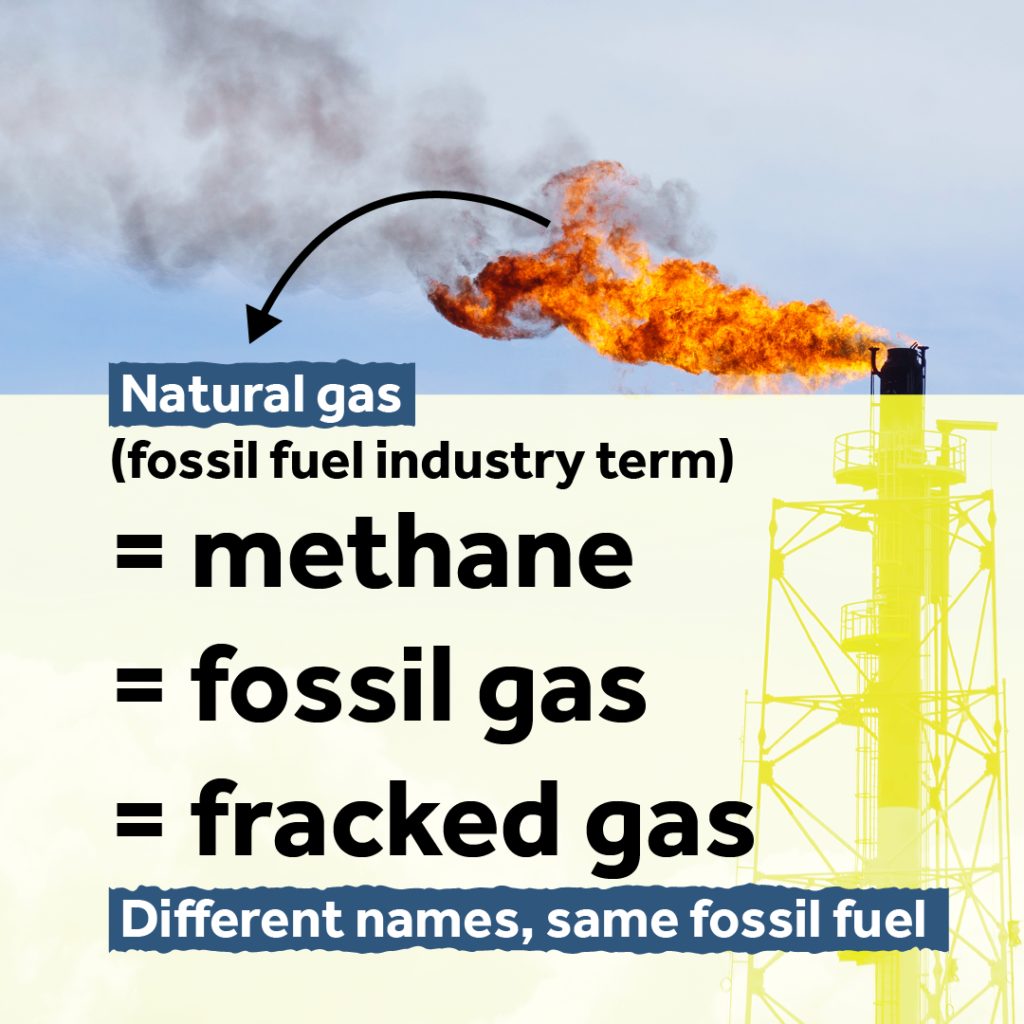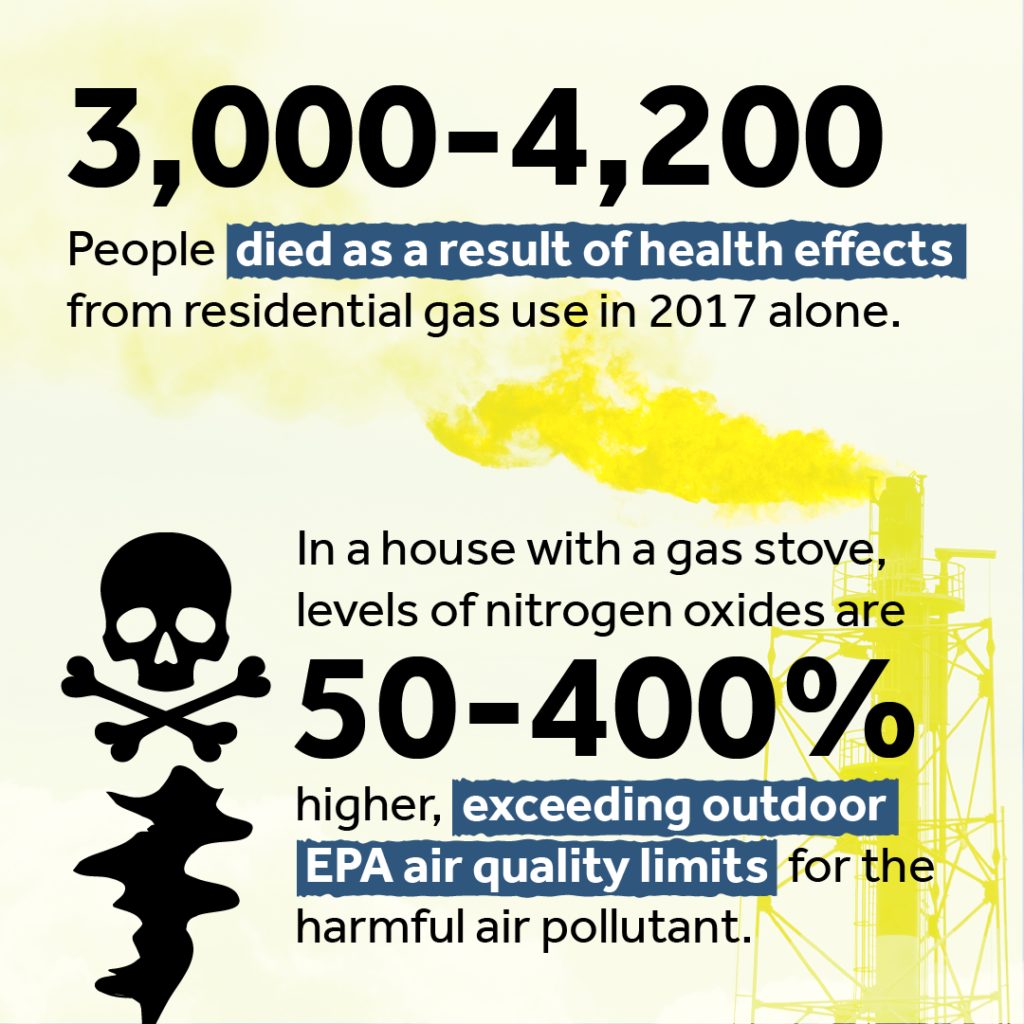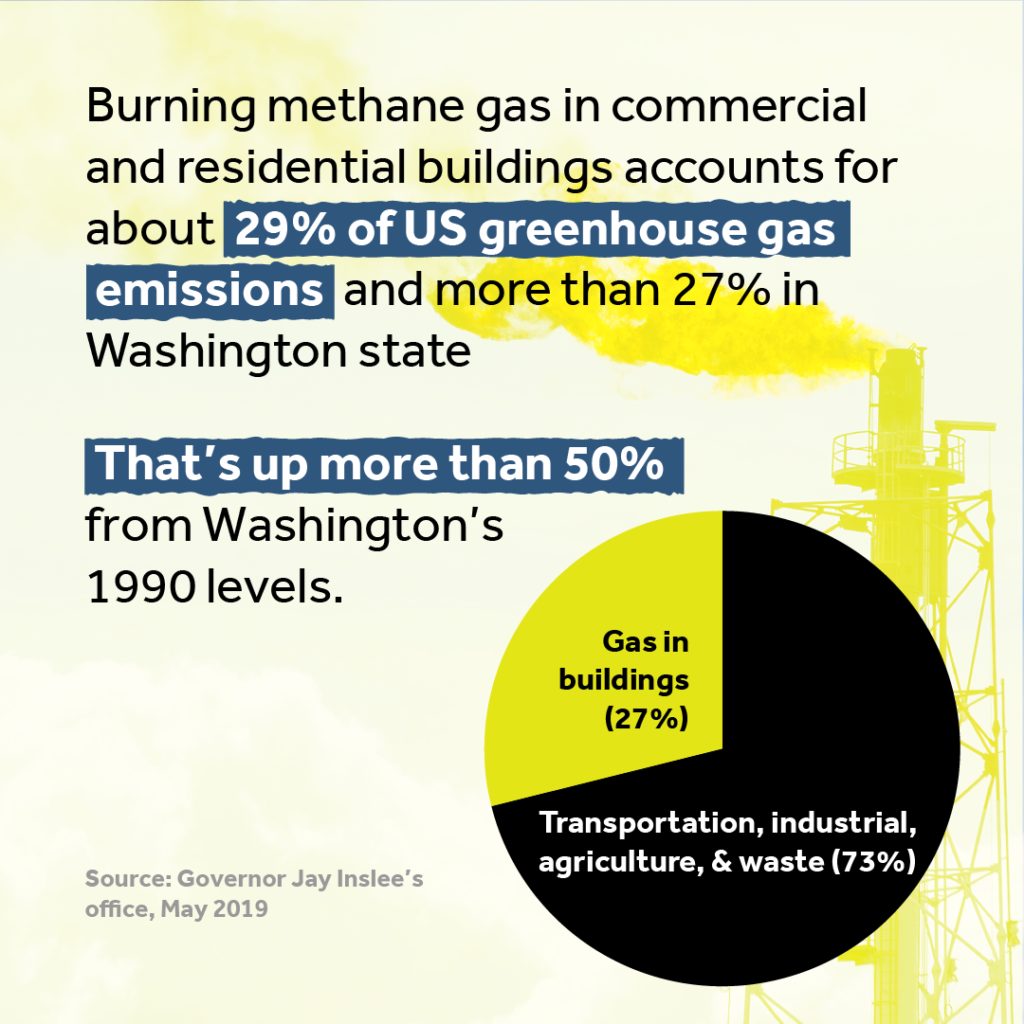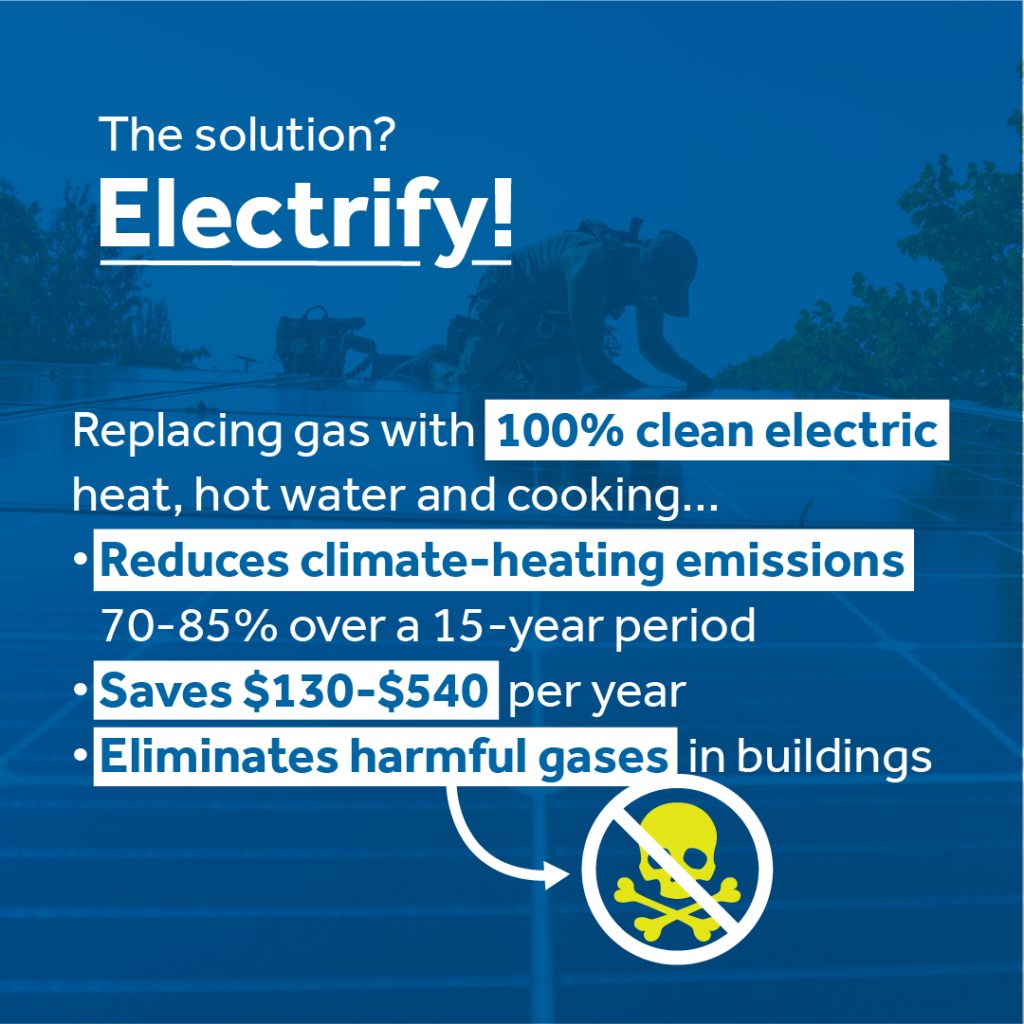Is natural gas clean, really? The latest report from the IPCC shows that not only do we need to stop burning fossil fuels, like RIGHT NOW, we absolutely have to cut methane (AKA the primary component of natural gas) emissions to come anywhere close to slowing climate change within the next few decades.
Yet the fossil fuel industry continues to mislead the public through disinformation campaigns, making it more difficult to pass no-brainer climate policies that protect our health and the planet. We don’t have time to fight bogus PR campaigns when what we need is all hands on deck fighting climate change. Now that coal and oil have been exposed as the polluting energy sources they are, fossil fuel corporations are putting all their eggs in one more smelly basket: gas.
In this post, we’re breaking down the myths, BS and dare we say, gaslighting, that the fossil fuel industry has used to manipulate the facts and our feelings about natural gas.
Is natural gas clean and how “natural” is it?

Natural gas is a fossil fuel that forms deep underground under high pressure from decayed organic matter deposited over the last 550 million years. This gas is composed almost entirely of methane (70 – 90 percent) which is highly flammable.
But the word “natural” is a pretty misleading way to describe it. While gas is “natural” in the sense that it comes from the earth, the harmful way we extract it, burn it and release it into the atmosphere is detrimental for public health and for the planet (see below).
It’s more accurate to refer to “natural gas” as “methane gas,” “methane,” “fossil gas,” or “fracked gas,” (as the Northwest’s gas supply comes primarily from hydraulic fracturing, or “fracking”, across the country).
And it’s not just semantics. The way we refer to this gas has power. A study from the Yale Program on Climate Change Communication found that the word “natural gas” evoked much more positive feelings than the words “methane” or “methane gas” among both Democrats and Republicans — even though natural gas and methane gas are THE EXACT SAME THING.
The natural gas industry benefits A LOT from the word ‘natural.’ It allows them to lump themselves in with actual clean, natural sources of energy (solar, wind and more!).
92 percent of gas use in buildings comes from space heating and water heating.
Emissions from natural gas consumption represent about 80 percent of the direct fossil fuel CO2 emissions from the residential and commercial sectors with a staggering amount of that burned for heat. But now that we’ve got that out of the way, we can talk about gas stoves — only about 8 percent of actual household methane use, but a big part of gas’ negative health effects and the industry’s campaign to keep us hooked on gas.
Now you’re cooking with gas (and formaldehyde, carbon monoxide and nitrogen dioxide)

Stoves, furnaces and water heaters powered directly by methane gas inside our homes are totally fine though, right? Gas companies want you to think so, and spend a lot of cash to convince you of it. Take for example, the Pacific Northwest group Partnership for Energy Progress, partially funded by Washington state’s largest gas utility Puget Sound Energy “has spent at least $1 million opposing electrification mandates in Bellingham and Seattle, including $91,000 on bus ads showing a happy family cooking with gas next to the slogan “Reliable. Affordable. Natural Gas. Here for You.”
That’s despite numerous studies showing that gas burning stoves and furnaces emit dangerous pollutants like formaldehyde, carbon monoxide and nitrogen oxides. In a house with a gas burning stove, nitrogen dioxide levels are approximately 50 – 400 percent higher, exceeding outdoor EPA air quality limits. And we’re using outdoor air quality limits here because we don’t even know what indoor air pollution standards should be in the U.S. Despite the fact that Americans spend nearly 90 percent of their time indoors, the U.S. has not set indoor pollution standards.
Breathing in these pollutants takes a serious toll on our health. A study by UCLA Fielding School of Public Health showed that kids in homes with gas stoves are 42 percent more likely to develop asthma symptoms and at a 24 percent higher risk of developing asthma later in life than children whose families use electric stoves. The Harvard T. H. Chan School of Public Health study estimates that 3,000-4,200 people died as a result of health impacts from residential gas use in 2017 alone.
While a range hood that vents outside can help with some ventilation of these pollutants, a study from UCLA notes that fewer than 35 – 54 percent of households actually use their range hoods while cooking (and gas companies rarely express the necessity of proper ventilation hoods to use their products). Other range hoods don’t cover all the burners and still others have only recirculating fans (which just pushes the pollution around the house) or no range hood at all. Even EPA guidance on hazardous air quality days says to “avoid activities that create more fine particles indoors, including smoking cigarettes or using gas, propane or wood-burning stoves and furnaces.”
These health risks didn’t stop gas companies like the American Gas Association and the American Public Gas Association from paying healthy, clean-living Instagram influencers to tout the perks of cooking with natural gas while disregarding the high health risk that comes with it. Or creating entirely fake people and fake movements like “Women For Natural Gas” to gush over the benefits of gas.
The truth is, when we turn on our gas stoves, and especially our gas ovens, we’re filling our homes with the same pollutants from car exhaust which leads to respiratory problems and cardiac disease. Guess that doesn’t make for as catchy an Instagram post, does it?
Gas can be as bad for the climate as coal

If the health impacts don’t rile you up, the climate impacts likely will. Burning methane gas in commercial and residential buildings accounts for about 29 percent of US greenhouse gas emissions and more than 27 percent of GHG emissions in Washington state (up more than 50 percent from 1990).
Gas isn’t a ‘bridge fuel’ we can cross as we move toward a clean energy future (despite the gas industry’s numerous marketing campaigns to convince the public otherwise). When the full lifecycle is taken into account, gas can be — and often is — worse for the climate than coal.
Scientists estimate that if a gas system leaks unburned methane at a rate above 2.7 percent, that system will have the same climate change impacts as coal. And considering the Gas Index reports that the national leakage rates for residential and commercial gas systems average around 4 percent, gas is just another dirty fossil fuel that would be better left in the ground.
Yet Northwest Natural and the gas industry are ramping up their disinformation efforts, promoting gas as a fuel that can help Southwest Washington reach its carbon emissions reduction targets. It’s clear we absolutely will not reach Washington’s climate reduction targets (95 percent reduction below 1990 levels by 2050) by burning more fossil fuels.
So what can we do?

There’s a straightforward solution to this massive climate and public health issue from burning gas in our homes: electrify our buildings. Induction stoves, electric heat pumps and electric water heaters are already more efficient, more cost-effective and safer for our health and planet than their methane alternatives. And when we talk about electric stoves, we’re not talking about your parents’ clunky electric stovetops. Today’s induction stoves offer finer heating control for cooking, and the safety feature of only heating while in use.
However, the fossil fuel industry has already launched their attack on policies and regulations that could help cities and states move toward all-electric buildings. The gas industry has worked aggressively (with lots of ratepayer money — i.e. YOUR money) in seven states to prevent cities from passing cleaner building codes. Just check out this ballot initiative heading toward the ballot this November in Spokane, Washington which would have barred city leaders from stopping new gas hookups, which are incompatible with both Spokane and Washington state climate goals. (Thankfully, it was recently stopped by a judge for going beyond the scope of a ballot initiative.)
What you’re not hearing from these gas companies is how building electrification has been found to reduce GHG emissions and make new buildings less expensive. In the Northwest, building electrification can reduce GHG emissions 70-85 percent over a 15-year period as well as saving $130 – $540 a year in lifecycle savings. In fact, the Rocky Mountain Institute found that all-electric homes in Seattle cost $4,500 LESS than a mixed-fuel home, mostly due to the avoidance of an estimated $2,100 to bring a gas connection to the building. The California Energy Codes and Standards statewide utility program found that a mixed-fuel medium size retail store cost between $21,762 and $32,504 more than an all-electric version and a mixed-fuel small hotel costs between $1,294,276 to $1,300,552 more than an all-electric version.
Between better public health, a safer climate and more affordability, it’s not a matter of if we’ll move toward building electrification and away from gas, but when.
Join us at RE Sources in the electrification transition now.
